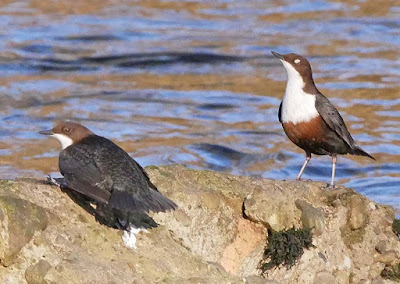Three late-winter fungi that have been very conspicuous here this month.
Scarlet elf cup Sarcoscypha austiaca. Always a joy to find, especially when it's nestling in a bed of mosses. More about this species here.Saturday, February 25, 2023
Some late winter toadstools
Wednesday, February 22, 2023
Robin with a deformed beak
I have seen similar beak deformities in starlings, but the most spectacular example was the herring gull in this post.
Monday, February 20, 2023
Yew tree pollination
February is the month when the tiny male cones of yew trees begin to shed their yellow pollen. These were photographed in Teesdale a couple of days ago.
Yew trees are dioecious - either male of female - and the male pollen is carried on the wind to single female ovules hidden amongst the foliage on another tree. These are tiny and can be hard to spot, but here is one, ready to receive pollen.
After fertilisation the outer wall of the ovule swells to become a soft, fleshy, aril that surrounds the single hard seed inside. It turns bright red in autumn, to attract the attention of birds.
Every part of a yew tree, except the aril, is poisonous to humans but thrushes, fieldfares and redwings quickly devour them. Nuthatches extract the hard seed, wedge it into crevices in yew trunks and hammer it open to extract the kernel. There's more about them in this Guardian Country Diary.
Thursday, February 16, 2023
A close view of a hungry redpoll
I usually only see redpolls in silhouette, as twittering flocks feeding on seeds high in the canopy of birches and alders, so it was a surprise and a delight to find this one only a few yards away. It was feeding on seeds of rosebay willowherb, on the unmanaged grassy verge of the Deerness Valley Walk, a local disused railway line that is now a popular footpath.
I wrote about it in the Guardian Country Diary this week.
Occasionally, when we get freezing weather with heavy snow lingering on the ground in late winter, we have had redpolls visiting the garden bird feeders, but we haven't witnessed such a visit since 2013.
Wednesday, February 8, 2023
Dipper courtship
I watched this pair of dippers courting along a stretch of the river Wear near Wolsingham in Weardale earlier this week. It's very difficult to tell the sexes apart but I'm pretty sure that's the male on the right, with his body stretched upwards. The female is fanning her tail and fluttering her wings. There's some brief wing fluttering going on in the second picture too.
The distinctive white eyelid of the bird that is blinking shows nicely.
Apart from this posturing, courtship seemed to mainly consist of the male pursuing the female up and down the river. Dippers always nest here, under an overhanging rock on the riverbank, and have a well-defined territory; rival pairs tend to confront each other at territorial boundaries early in the season, and usually turn back when they reach a rival's territory. They also sing with notes that are pitched at a level where they can be heard above the tumult of the river.
Sunday, February 5, 2023
These old Cotoneaster bushes are rooted in fissures in the limestone cliff behind Ashes quarry are Stanhope, in Weardale. Cotoneaster is a genus with many species, mostly from Eastern Asia, that has long been cultivated in Britain for its attractive berries in autumn; these plants would undoubtedly been of garden origin, originally arriving in the quarry in bird droppings. Although almost all berries in the dale have now been eaten by birds, this heavy crop remains almost untouched. This happens every year, and there is no obvious reason why birds should not have taken them. Maybe a flock of redwings or fieldfares will find them soon.
Wednesday, February 1, 2023
Sleeping beauty awakes
This lovely peacock butterfly must have found its way into the house, unnoticed, during the very mild weather last October, and has been hibernating here ever since. It woke up late one evening a couple of weeks ago. After settling for a while on the television screen, it flew into the kitchen and began drinking water from a damp washing-up sponge. Central heating must have made it thirsty.








































